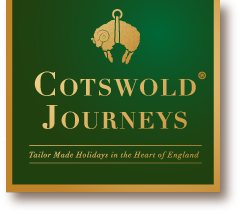It goes without saying that a church is a place of worship. But the fact is that today, when religion is no longer universally followed, churches can have a supplementary role in our lives, as three-dimensional representations of our history. In fact, in England, there are no more accessible and expressive sources of our past than in our ancient churches, an example of which is in every village throughout the Cotswolds. From the churches, we can know our past, just as if we reading about it. One of England’s largest parish churches stands, cathedral-like, in the town center, on the fringe of the market square. To enter through its late fifteenth-century fan-vaulted porch is to be immediately surprised at two things – first, that unlike most churches it is warmer inside it than outside it (courtesy of a new heating system) and second, at its vastness. Your gaze is unavoidably transported upwards to the nave roof, which, courtesy of local Cotswold wool merchants, was raised in the early sixteenth century by a further twenty feet above its original and already impressive twelfth-century beginnings. The arches separating the nave from the aisles are tall and slender so the church is light, airy, and not remotely oppressive.
Cirencester’s church owes its grandness to wool because it was wealthy medieval and Renaissance merchants who ensured their immortality by paying for it to be enlarged to its current proportions. In the Trinity Chapel, built on the north aisle, there are some magnificent brasses to these merchants, pictured surrounded by wives and children, feet firmly on the source of their prosperity, a staple of wool. To the right of the Trinity, altar are ‘squints’, breaches in the wall allowing the officiating priest to follow events at the main altar. Above your head in the adjoining Lady Chapel is a wonderful medieval wooden ceiling, in which is concealed, eccentrically, a carving of a cat and a mouse. Beside the fifteenth-century pulpit is an hourglass (no longer used apparently) to prevent the sermon from continuing beyond what was bearable for the congregation. There are ancient chests, fragments of medieval murals, and a cup made for Anne Boleyn and later given to her daughter, the future Queen Elizabeth I.
Cirencester parish church is a masterpiece of Perpendicular architecture, a joint enterprise between the abbey, which until the Dissolution owned the wool market, and the wool merchants, who, as their wealth grew, chafed at the restrictions imposed on them. Nonetheless, it was the merchants who paid for the nave and tower. The commercial outlook of the Church at the period is best illustrated by what is perhaps the most striking (and celebrated) part of the church, the magnificent south porch, possibly the largest and grandest in England. Porches were important, as it was here that the clergy dealt with many of their administrative and parochial duties. In some cases, upstairs floors were added (known as ‘parvises’, as at Malmsbury) – here there were three upper floors (the uppermost was removed in the nineteenth century), the first two of which were occupied by the wool guilds.


0 Comments